Emmylou Harris
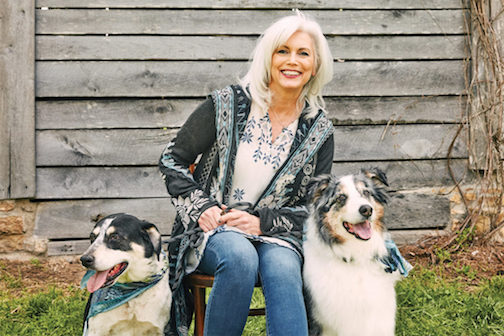 The very multi-talented musician and animal advocate Emmylou Harris is our special guest for this week's Season of the Stars. Emmylou runs an animal rescue on her property in Nashville.
The very multi-talented musician and animal advocate Emmylou Harris is our special guest for this week's Season of the Stars. Emmylou runs an animal rescue on her property in Nashville.
"Animals - That's what I want to devote my life to now," Emmylou Harris stated. The angel-voiced singer has been wowing audiences for decades, and as one of music's leading vocalists, has earned 12 Grammy Awards. Emmylou states that the animals have wriggled their way into her heart and life. She now feels that she has the time and opportunity to give back a little to these critters that have given her so much.
In her adult years, one of Harris' closest canine companions was Bonaparte, a poodle mix who traveled with her on tour and lived to age 15. As a result, Harris founded her own fostering operation, which she calls Bonaparte's Retreat. She has turned part of her yard into a small shelter, complete with runs and doghouses for up to three pooches at a time. Currently, her foster dogs are close to or more than 50 pounds and in need of permanent families all their own. She noted that she always tries to help out those dogs that seem to be the hardest to place—those who are older, have been relinquished more than once, or have been available for adoption for a while.
She states giving up these dogs that she has rescued to a new family is not the hard part. The hard part is when she has a vacancy and goes to select a new dog. Unfortunately, there is always more than one dog that needs a home and it is hard to leave the others behind knowing that they will probably end up being euthanized. They key is getting more people to foster these animals. And if you can't foster, perhaps you can spend a few hours each week at a local shelter and just walk the dogs. It is so important for these dogs that may be euthanized to have some kind of human contact. People in the shelters are overwhelmed and if the community came together and helped, everyone would benefit. There are so many problems in the world, but this is a problem that can be overcome by spaying and neutering.
Harris feels that animals are given to us to make our lives better and they are also sort of a test. It's as if, "God says if you can't get this one right, then I don't even want to know you!" She also feels that animals teach us how to be good people and enrich our lives in so many ways.
It seems only natural that Harris would be so concerned about animals. Her father was training to be a veterinarian at the University of Virginia when World War II began. He abandoned his veterinary studies to join the armed forces, get married and start a family. Harris was raised near Quantico, Virginia, where her father was stationed for more than a decade. Later, she started her music career in Washington, D.C.
Visit Website
11th Annual Cross-country Pet Adoption Tour: Get Your Licks on Route 66
Susan Sims, Fido Friendly Magazine
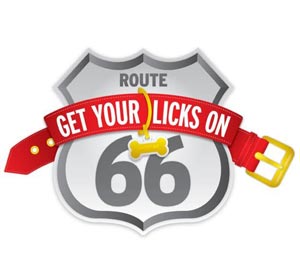 The Eleventh Annual Get Your Licks on Route 66 Adoption Tour recently kicked off in Los Angeles. The Get Your Licks on Route 66 Adoption Tour is an annual cross-country pet adoption tour. They start in Los Angeles and go all the way to Chicago and work their way back. The tour is to help raise money for the shelters along the way and to raise awareness for the plight of these shelter animals. Their first 10 Get Your Licks on Route 66 Tours helped place over 13,000 pets into new forever homes.
The Eleventh Annual Get Your Licks on Route 66 Adoption Tour recently kicked off in Los Angeles. The Get Your Licks on Route 66 Adoption Tour is an annual cross-country pet adoption tour. They start in Los Angeles and go all the way to Chicago and work their way back. The tour is to help raise money for the shelters along the way and to raise awareness for the plight of these shelter animals. Their first 10 Get Your Licks on Route 66 Tours helped place over 13,000 pets into new forever homes.
Today the tour takes them to Midwest City, Oklahoma. Susan brings her giant spinning filled with prizes donated by their sponsors. Sponsors include Blackwood Pet Food, Paws n Claws, Zymox, Tito's Vodka, Hands on Gloves, Buddy Belts, Rolf C. Hagen, Doggie Water 2 Go, Affordable Allergy Testing, Bike Tow Leash, Bulletproof Pet Products, Charlee Bear, The Company of Animals, The Emergency Tag Help 4 Pets, Jiminys, John Paul Pet, Merrick, Petpetwua, Shed Defender, Surfeit, Zen Den, Walkin' Pets by Handicapped Pets and Unified Pet.
Here are the upcoming dates for the tour:
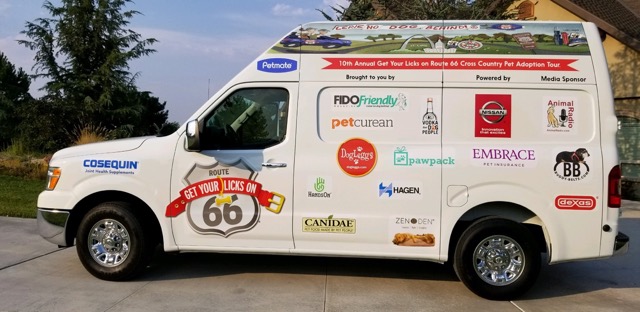 October 6
October 6
St. Louis, Missouri 10:00am-3:00pm
Animal Protection Association of Missouri
Tiles Park, K-9 Carnival, 9551 Litzinger Road
October 10
Springfield, Illinois 11:00am-3:00pm
Animal Protection League
PetSmart, 3183 S. Veterans Pkwy
 October 12
October 12
Chicago, Illinois 11:00am-3:00pm
PAWS Chicago, 1997 N. Clybourn Ave.
Even if you are not planning on adopting a new family member, come on out and have some fun and see the animals. You can also win prizes on the spinning wheel, with donations going to your local shelter. It's a great way to support your local shelter and have fun at the same time.
Visit Website
How To Achieve Litter Box Success - Dr. Debbie
 It's important to realize not all cases of inappropriate elimination are a "behavior" problem. In confirmed behavioral driven house soiling cases, 20-percent of the cats also had a contributing medical condition at the time. So even if it sounds like a behavioral problem, see your veterinarian to ensure your cat isn't the 1 in 5 that has discomfort, infection, or other health problems influencing her litter box use.
It's important to realize not all cases of inappropriate elimination are a "behavior" problem. In confirmed behavioral driven house soiling cases, 20-percent of the cats also had a contributing medical condition at the time. So even if it sounds like a behavioral problem, see your veterinarian to ensure your cat isn't the 1 in 5 that has discomfort, infection, or other health problems influencing her litter box use.
Drawing Kitty To The "Right" Spot
Check the condition of the box - is it urine stained on the bottom? Throw it out and get a new one. Keep the box clean by scooping twice daily and by performing a complete litter change out twice a week for non-clumping litter or every 2-3 weeks for clumping varieties.
To entice kitty back to the litter box try a litter box attractant like the herbal-based cat litter additive called "Cat Attract."
Multi-cat homes or those with outdoor cats nearby should use pheromone (scent hormone) products to ease social stress and facilitate litter box harmony.
Kitty Eliminates Near, But Not Quite In The Litter Box
Your kitty is telling you that she understands what you want her to do, but something isn't quite right in the litter box environment. First start with providing a larger box, even if this means buying a plastic under bed storage box for this purpose. Look for one sized 18 x 36 inches in size.
Remove any litter box covers. Revisit the traffic flow in the litter box area. Ensure the box is in a quiet, low traffic area. Keep the box unquestionably clean.
Is Your Cat Urinating In Tubs Or Sinks?
Chances are your cat has urinary tract inflammation or infection. The cool surfaces provide relief to the inflammation or discomfort of a medical condition. See your veterinarian for a urine evaluation and treatment since environmental changes alone will not stop the behavior.
To preventing further episodes, decrease access to tubs and sinks, close doors to bathrooms, or fill the bottom of sinks and tubs with a small amount of water.
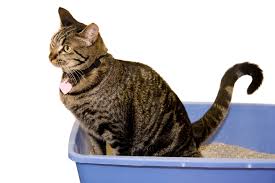 Kitty Eliminates On Throw Rugs And Won't Use Litter Box
Kitty Eliminates On Throw Rugs And Won't Use Litter Box
Your cat has already made a litter preference. Perhaps the texture of carpet is more appealing than the litter used. Provide a litter box smorgasbord. This is when you provide multiple litter pans at the same time, each with different litter varieties such as clay, clumping, and natural pine litter. Be sure to include one litter box with sections of throw rugs or carpet remnants lining the bottom. During this time, remove all throw rugs from the house or block kitty's access to those areas.
If kitty demonstrates a litter preference, switch her litter boxes to that style of litter.
If kitty chooses the rug-lined box, then continue providing carpet lined litter boxes to establish a good pattern of repeated box use. Gradually start sprinkling small amounts of cat litter in the box on top of carpet surface. With time, many cats can be retrained to accept the box as the carpet is phased out and just litter remains.
Prevent Returning To Scene Of Crime
Clean all house soiling accident sites with an enzyme based pet cleanser. The enzymes break down the chemical component of the odors, and do more than just cover up with scents. Do not use ammonia based cleansers on accident areas - doing so is counterproductive. (Remember that urine contains ammonia products.)
Cats dislike eating in areas that they eliminate, so place food and water bowls in the site of the accidents, or try placing pieces of aluminum foil in areas to deter kitty's use.
Citrus scents are offensive to cats and can be an effective cat deterrent. Use citrus or potpourri scented air fresheners in the area. If your cat is eliminating in house plants, place lemon or orange peels in the pot to make the area less attractive. And of course, make sure you aren't using citrus scented cleaners on the litter pan!
To keep your kitty away from areas she continues to eliminate on, use double sided sticky tape or turn plastic carpet runners upside down. Another option is to invest in motion-activated devices that spritz out citronella or puffs of air when the electronic eye picks up motion in the off-limits area.
The Tough Reality
For some cats, environmental changes aren't enough and drug therapy may be a necessary tool. But remember that behavioral medications aren't a shortcut - drug therapy must be used with veterinary monitoring and in conjunction with environmental changes.
Want to hear some bad news? In households struggling with many years of feline house soiling, it may be necessary to discard urine marked furniture, change out carpet, carpet pads, and treat sub-flooring to effectively remove scent triggers for future elimination issues. It may sound extreme, but it can be important step to achieve faithful feline litter box success.
Featured veterinarian known as "Dr. Debbie" on national pet radio program, Animal Radio. Ebook author of "Yorkshire Terriers: How to Be Your Dog's Best Friend"; "Pugs: How to Be Your Dog's Best Friend"; "Mini Schnauzers: How to Be Your Dog's Best Friend"; and "Shih Tzu: How to Be Your Dog's Best Friend." Dr. Debbie's books.
Visit Website
 The Dogfather's Grooming Tip with Joey Villani
The Dogfather's Grooming Tip with Joey Villani
Clipping The Hair Between Dog's Toes
Joey was recently asked by a woman, "Why does my groomer want to clip the hair in between the pads of my dog's feet?" While Joey has discussed this before, he never really discussed why it is done.
People have domesticated dogs and have changed their coats. This has taken thousands of years for our dogs to evolve into the coats that we have today. Because of this, pet's coats don't work the way they probably did when they were the original wild dogs. These coats would automatically shed out and new growth would happen.
However, we developed all of these pure breeds and changed their coats. Some of these new coats don't shed out, like the long flowing coats of ShihTzus, Malteses, etc.
The pads in these dogs also don't shed out. Dogs perspire through their tongue and with the pads of their feet, so they get wet. You might even see some of these dogs chewing at their feet, because they are irritated.
When their pads get wet, the hair matts up in the pads. This hair will then get as hard as a rock and become uncomfortable for them to walk. It can also limit their mobility.
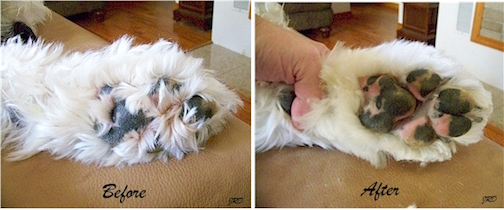 This becomes almost like athlete's foot, because a fungus builds up in the hair. This hair needs to be removed before it matts, and plus it lets them perspire better.
This becomes almost like athlete's foot, because a fungus builds up in the hair. This hair needs to be removed before it matts, and plus it lets them perspire better.
There are some dogs, like German Shepherds, where their coats will automatically shed out. This means that the hair between their footpads will also shed automatically. This will only happen with dogs with short coats. There are some longhaired German Shepherds, which will need to have this hair clipped.
Animal Radio News - Stacey Cohen
 PETA & Sex Go "Hand In Hand"
PETA & Sex Go "Hand In Hand"
PETA is known for using controversial methods to bring attention to animal issues. With the launch of PETA.xxx, a sexy website featuring Ron Jeremy, Jenna Jameson, Rose McGowan and the controversial Sasha Grey, the animal rights organization is attempting to raise awareness for animals. Although some might question PETA's unorthodox strategy, the site does offer a lot of important information on animal welfare and might prove to be educational for many. The site is relatively work safe, and if you're looking for something intense under the "Hardcore Videos" section you might be in for a surprise.
It's Foxtail Season, And A Booming One It Is!
Foxtails are produced by a number of non-native grasses. They're sort of torpedo shaped with tiny barbs that allow them to stick to anything to which they come in contact - including fur on animals. Once attached, problems can occur. Because the barbs are angled to allow forward progress and disallow reverse, a foxtail can get into a dog's ear canal and continue to burrow down toward the eardrum. They can even penetrate through the drum and cause severe ear damage and infection. As one might imagine, this is uncomfortable for the dog. The ear, however, is but one area that might be invaded by these foxtails. If you take your dog to areas where foxtails lurk, make sure you check them over after the day's play. Pay especially close attention between the toes, as foxtails can bore into the skin between the toes and migrate internally up the limbs. Check around the ears, and hope also that your dog didn't snort one up its nose. This almost always involves sneezing violently, so it is usually easy to know when that happens. Foxtails can also get into the eyes and cause damage to the cornea.
 Scat Detecting Dogs
Scat Detecting Dogs
A study published in the online science journal PLoS ONE was the first to use "Scat-detection dogs" to find the feces of endangered killer whales for research. Tucker, the black Labrador in the study, was able to detect the endangered whale's poop from as far as a mile away. Tucker did his job by boarding a small boat that lingered near the whales. Scientists used the technique to determine the levels of stress and hunger hormones in the feces so that they could analyze the affects of stress on malnourished orcas. According to the study, the approaching boat season stresses out orcas but not more than being underfed. And these beasts are hungry because there are not enough salmon to sustain this already-declining species. Katherine Ayres, the lead researcher from the University of Washington, said in a news release that whales are often difficult to study because they spend 90-percent of their time underwater.
Do You Use Your Dog As Date Bait?
Whether warranted or not, deep down, people who love animals instinctively believe they can trust a fellow animal lover. Taking that premise a little further, both women and men have lots of preconceived notions about what their favorite breed of dog says about them to the opposite sex. Would you use your Dalmatian to get a date with a like-minded person? Do people use their dogs as date bait? A recent survey about what breeds are attractive to the opposite sex done by Klooff, a mobile application for pet lovers, revealed that if attracting a date is your goal, you can't go wrong with retrievers, popular breeds for both sexes. The survey results are based on responses from 1,000 pet owners and non-owners between the ages of 18-33. According to the survey, the top dog breed to attract men is Golden Retrievers, followed by Labrador Retrievers, Chihuahuas, Poodles and Beagles. For women, the top breed of dog to attract them to men is German Shepherds, followed by Golden Retrievers, Labrador Retrievers, Huskies and French Bulldogs.
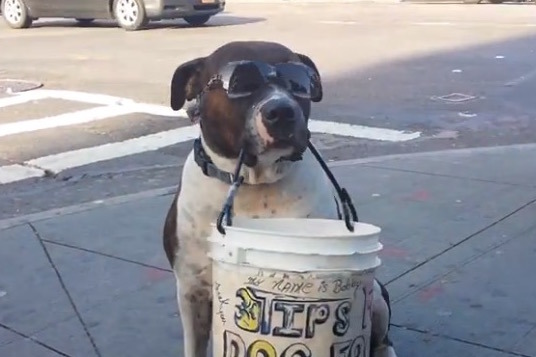 Puppies Instead of Panhandling
Puppies Instead of Panhandling
Puppies have some pretty magical powers: the ability to look cute from all angles, the ability to pee wherever they want. And now, they may also have the power to address San Francisco's panhandling problem. The city will initiate a new program August 1st, believed to be the first of its kind in the country. WOOF (Wonderful Opportunities for Occupants and Fidos) encourages homeless individuals to give up panhandling. In exchange, they'll receive a small stipend to foster problematic puppies until they're ready for adoption. Bevan Dufty, San Francisco's point-person on homeless issues, said his goal is to try to help both the city and its animals. San Francisco Animal Care and Control will screen potential foster parents to ensure that they are a good fit for the program. They must live in supportive housing, not on the streets, and prove they are not severely mentally ill, aren't hoarders, don't have a history of violence and aren't seeking treatment for addictions. They must also promise to stop panhandling, and if they are caught begging with the puppy, the animal will be taken back to the shelter. In exchange, the approved applicant will receive $50-$75 a week, as well as several training sessions, regular check-ins, and all the dog food, toys, leashes and veterinary care they need, provided by Animal Care and Control. As the program expands, the participants will ideally be trained in grooming, dog walking and other animal-related skills so that they can join the regular workforce.
 Listen to the entire Podcast of this show (#1035)
Listen to the entire Podcast of this show (#1035)





